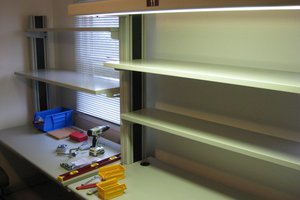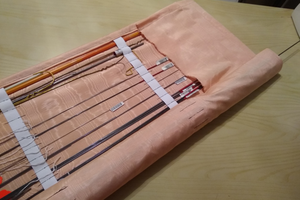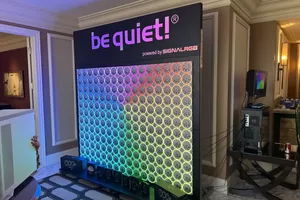The structure
The main structure of the desk bridge is made from 3/4" plywood; two side panels, the top shelf, and two corner gussets. An 8'x4' sheet from Menard's was more than enough material. At the joints of the sides, top, and corner gussets, composite wood material (UltraDeck brand from Menard's) was used to hold bolts; these 'spindles' are super easy to work with and don't splinter.
The two side plywood panels have spindle bolted to them, which sits on the IKEA desk surface. Pull pins go through the desk and into aluminum angle pieces which are bolted to the side panels. The spindle supports the desk bridge on the desk, while the pinned aluminum angle restrains the side panels horizontally
Sanding, staining, sanding, and sealing the plywood was the slowest part of the project, but definitely worth it. I used black 'push-in stem' plastic trim after routing a groove in the front-facing plywood edges, which worked great.
The sliding portion
A few inches under the top plywood shelf, two 1" square aluminum tubes span the width of the desk, sticking out either side. These tubes are the 'rails' that support the monitors and speakers, and are about 19" apart. I used my 3d printer to make 'square-to-circle' adapters to hold the square rails in circular holes in the side panels.
For each hanging monitor, a pair of 0.75" aluminum angle pieces slide side-to-side on top of the rails. In turn, these angle pieces support a plywood platform which can slide from the front rail to the back rail and vice versa. In conjunction, I have the ability to slide the monitors in both directions whenever I need to.
Mounting the monitors
From the sliding platforms, the monitors hang. 1" aluminum pipe of various lengths sits in bronze bushings, with a shaft collar at the top. The shaft collar holds up the entire weight of a monitor. Since a monitor's center of mass is outside the tubing, the monitors exert a moment on the tubing. The sliding platforms are large enough to encompass the monitor's center of mass, but the bronze bushing tends to pop out of the platform (in part due to a loose fit). To counter this behavior, the rectangular washers with two holes that come with u-bolts were repurposed to clamp down on the bushings.
The monitors are bolted to scrap squares of 3/4" plywood, aka cheap VESA mounts. Each mount has two u-bolts, which are secured by lock nuts that sit in counter-bored pockets in the plywood. The aluminum tubing goes through the two u-bolts. Between the u-bolts, a shaft collar holds the monitor at a given height. (The shaft collar also sits in a milled pocket in the plywood VESA mount.)
 Gertlex
Gertlex
 Quinn
Quinn

